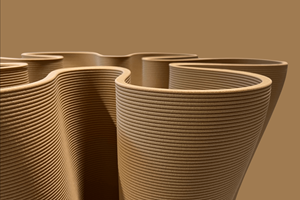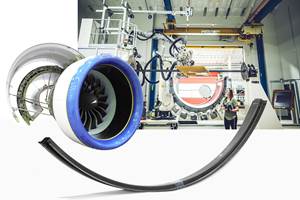Smartbeam develops HMS-embedded composite profiles for space
Project goals adapted filament winding to properly integrate optical and carbon fiber sensors and meet technical requirements, resulting in a verified, simplified process for smart composite structures at reduced cost.
Share
Bending test setup. Source (All Images) | Smartbeam project
(Sušice, Czech Republic) reports on its participation in the Smartbeam project led by spacecraft and launcher structures supplier (Brno-Medlánky, Czechia). Supported by Future Innovation Research in Space Transportation (FIRST!), a Space Transportation (ESA STS) Future Launchers Preparatory Program (FLPP) initiative, Smartbeam’s main objective is to create affordable and scalable manufacturing methods to enable the production of off-the-shelf smart composite structures for space applications. Through this, project partners aimed to develop and test a carbon fiber-reinforced polymer (CFRP) beam with an embedded health monitoring system (HMS).
The project focused on two key goals: a universal manufacturing process, and an embedded HMS. Partners wanted to develop a universal process for producing CFRP trusses that allows manufacturing tubes with an integrated HMS in a wide range of dimensions (length, internal diameter, wall thickness and fiber orientation) at an attractive cost. Implementation of an HMS would enable real-time structural monitoring without significantly increasing manufacturing costs or compromising mechanical performance.
Why was this development important for space structure applications? Technologies like Smartbeam are highly relevant in that it can significantly reduce inspection times by providing real-time structural health data. In reusable launchers, this minimizes ground time between launches. In spacecraft, it enables immediate identification of issues in orbit and targeted repairs or replacements of affected trusses, saving cost and reducing environmental impact by avoiding unnecessary disposal of undamaged components.
CompoTech was responsible for developing the universal manufacturing process to produce CFRP tubes with integrated HMS. This process needed to accommodate various geometries and dimensions while ensuring consistent product quality and maintaining competitive costs.

OHB Czechspace acted as the project leader and provided expertise on the space industry’s technical requirements for structural components. CVUT FS was in charge of designing and preparing HMS sensors for integration. It also conducted mechanical testing and nondestructive evaluation of samples.
In this project, CompoTech successfully developed the technology to integrate the optical measuring fibers used for the Distributed Fiber Optic Sensing (DFOS) method. This method is able to measure strain at points about 2.6 millimeters apart along the entire length of the optical fiber. Carbon fiber sensors were also integrated to enable impaction detection.
The carbon fiber sensors were incorporated directly during the filament winding process. They were placed between two layers of glass fabric prepreg to provide electrical insulation from the CFRP laminate. Optical fibers were positioned parallel to the carbon fiber sensors to simplify handling. The sensors were equipped with custom connectors, creating a plug-and-play interface that enables easy connection after manufacturing.
The winding process itself became a technical hurdle during Smartbeam’s development when determining how to prepare the sensors. The challenge, CompoTech explains, lay in precisely placing the connectors and meeting the high-temperature resistance requirements. Another issue that had to be solved was sealing the connectors against resin ingress during production.
To overcome this, the team developed several design iterations and practical tooling to support sensor handling and placement, and multiple versions of connector housings were prototyped and tested. Special 3D printed fixtures were made for the connectors, and a connection interface with connectors was integrated so that no additional assembly was necessary after the profiles were wound. The filament winding process was also adapted to precisely position the sensors and ensure even coverage of their connectors, with modifications that prevented resin leakage around the connectors, and met requirements for thermal resistance, sealing and consistent laminate coverage.
Upon completion, the project delivered:
- A verified manufacturing process for producing smart composite profiles with integrated sensors.
- Integrated connector interfaces eliminating post-production assembly steps.
- Solutions for resin sealing during curing.
- Verified sensor performance in mechanical and thermal tests.
- Initial evidence that carbon fiber sensors can detect impact under certain conditions.
Correct functioning of the sensors was verified during mechanical tests in compression and bending. Initial information was obtained regarding the possibility of using a carbon sensor for impaction detection on this type of wound profile during impactions. Partners agree that, compared to traditional composites manufacturing, the Smartbeam approach simplifies integration of HMS and reduces time and cost for system assembly, making it well suited to reusable launcher structures, spacecraft components and ground support equipment.
The next goal of the project is to increase TRL to at least 4 via breadboard validation in a laboratory environment.
Related Content
Bladder-assisted compression molding derivative produces complex, autoclave-quality automotive parts
HP Composites’ AirPower technology enables high-rate CFRP roof production with 50% energy savings for the Maserati MC20.
Read MoreSulapac introduces Sulapac Flow 1.7 to replace PLA, ABS and PP in FDM, FGF
Available as filament and granules for extrusion, new wood composite matches properties yet is compostable, eliminates microplastics and reduces carbon footprint.
Read MorePlant tour: Airbus, Illescas, Spain
Airbus’ Illescas facility, featuring highly automated composites processes for the A350 lower wing cover and one-piece Section 19 fuselage barrels, works toward production ramp-ups and next-generation aircraft.
Read MoreThe potential for thermoplastic composite nacelles
Collins Aerospace draws on global team, decades of experience to demonstrate large, curved AFP and welded structures for the next generation of aircraft.
Read MoreRead Next
Clean Sky 2 outer wing box demonstrator validates OOA LRI, shimless assembly and SHM
Full-scale wing box project achieves TRL 5 with 2% weight reduction and 4% reduction in recurring production costs through improved manufacturing efficiency and assembly processes.
Read MoreSensory consolidation roller for laser-based AFP enables innovative temperature measurement
Within the InSiTe project, IFW has demonstrated embedded fiber optic sensors for continuous measurement of temperature in the area of compaction with high spatial resolution up to 0.65 millimeter.
Read MoreAssembling the Multifunctional Fuselage Demonstrator: The final welds
Building the all-thermoplastic composite fuselage demonstrator comes to an end with continuous ultrasonic welding of the RH longitudinal fuselage joint and resistance welding for coupling of the fuselage frames across the upper and lower halves.
Read More









